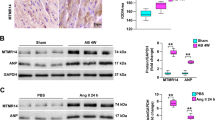Abstract
Objective
Cardiac hypertrophy is an adaptive reaction of the heart against cardiac overloading, but continuous cardiac hypertrophy can lead to cardiac remodeling and heart failure. Cardiac hypertrophy is mostly considered reversible, and recent studies have indicated that decorin not only prevents cardiac fibrosis associated with hypertension, but also achieves therapeutic effects by blocking fibrosis-related signaling pathways. However, the mechanism of action of decorin remains unknown and unconfirmed.
Methods
We determined the degree of myocardial hypertrophy by measuring the ratios of the heart weight/body weight and left ventricular weight/body weight, histological analysis and immunohistochemistry. Western blotting was performed to detect the expression levels of CaMKII, p-CaMKII and MEF-2 in the heart.
Results
Our results confirmed that decorin can regulate the CaMKII/MEF-2 signaling pathway, with inhibition thereof being similar to that of decorin in reducing cardiac hypertrophy.
Conclusion
Taken together, the results of the present study showed that decorin induced cardiac hypertrophy by regulating the CaMKII/MEF-2 signaling pathway in vivo, revealing a new therapeutic approach for the prevention of cardiac hypertrophy.
Similar content being viewed by others
References
Heineke J, Molkentin JD. Regulation of cardiac hypertrophy by intracellular signalling pathways. Nat Rev Mol Cell Biol, 2006,7(8):589–600
Cohn JN, Ferrari R, Sharpe N. Cardiac remodeling—concepts and clinical implications: a consensus paper from an international forum on cardiac remodeling. Behalf of an International Forum on Cardiac Remodeling. J Am Coll Cardiol, 2000,35(3):569–582
Gradman AH, Alfayoumi F. From left ventricular hypertrophy to congestive heart failure: management of hypertensive heart disease. Prog Cardiovasc Dis, 2006, 48(5):326–341
van Berlo JH, Maillet M, Molkentin JD. Signaling effectors underlying pathologic growth and remodeling of the heart. J Clin Invest, 2013,123(266):37–45
Koitabashi N, Kass DA. Reverse remodeling in heart failure—mechanisms and therapeutic opportunities. Nat Rev Cardiol, 2011,9(134):147–157
Manabe I, Shindo T, Nagai R. Gene expression in fibroblasts and fibrosis: involvement in cardiac hypertrophy. Circ Res, 2002,91(357):1103–1113
Gabbiani G. The biology of the myofibroblast. Kidney Int, 1992,41(206):530–532
Zeisberg M, Strutz F, Muller GA. Role of fibroblast activation in inducing interstitial fibrosis. J Nephrol, 2000,13(99):1121–8428
Goldoni S, Owens RT, McQuillan DJ, et al. Biologically active decorin is a monomer in solution. J Biol Chem, 2004,279(86):6606–6612
Yan W, Wang PC, Tang J, et al. Decorin gene delivery inhibits cardiac fibrosis in spontaneously hypertensive rats by modulation of transforming growth factorbeta/Smad and p38 mitogen-activated protein kinase signaling pathways. Human Gene Therapy, 2009, 20(51):1190–1200
Kudoh S, Akazawa H, Takano H, et al. Stretch-modulation of second messengers: effects on cardiomyocyte ion transport. Prog Biophys Mol Biol,2003, 82(29):57–66
Zhang T, Kohlhaas M, Backs J, et al. CaMKIIdelta isoforms differentially affect calcium handling but similarly regulate HDAC/MEF2 transcriptional responses. J Biol Chem, 2007,282(149):35078–35087
Abdel-Wahab N, Wicks SJ, Mason RM, et al. Decorin suppresses transforming growth factor-beta-induced expression of plasminogen activator inhibitor-1 in human mesangial cells through a mechanism that involves Ca2+-dependent phosphorylation of Smad2 at serine-240. Biochem J, 2002,362(60):643–649
Wang T, Hou LB, Liu ZJ, et al. Intramuscular delivery of rAAV-mediated kallikrein gene reduces hypertension and prevents cardiovascular injuries in model rats. Acta Pharmacol Sin, 2007,28(6):1898–1906
Sato K, Suematsu A, Nakashima T, et al. Regulation of osteoclast differentiation and function by the CaMK-CREB pathway. Nat Med, 2006,12(236):1410–1416
Kompa AR, See F, Lewis DA, et al. Long-term but not short-term p38 mitogen-activated protein kinase inhibition improves cardiac function and reduces cardiac remodeling post-myocardial infarction. J Pharmacol Exp Ther, 2008,325(46):741–750
Dunkman AA, Buckley MR, Mienaltowski MJ, et al. Decorin expression is important for age-related changes in tendon structure and mechanical properties. Matrix Biol, 2013,32(103):3–13
Dunkman AA, Buckley MR, Mienaltowski MJ, et al. The injury response of aged tendons in the absence of biglycan and decorin. Matrix Biol, 2014,35(44):232–238
Schaefer L, Tredup C, Gubbiotti MA, et al. Proteoglycan neofunctions: regulation of inflammation and autophagy in cancer biology. Febs j, 2017,284(78): 10–26
Horvath Z, Kovalszky I, Fullar A, et al. Decorin deficiency promotes hepatic carcinogenesis. Matrix Biol, 2014,35(50):194–205
Duncan MB. Extracellular matrix transcriptome dynamics in hepatocellular carcinoma. Matrix Biol, 2013,32(17):393–398
Patel S, Santra M, McQuillan DJ, et al. Decorin activates the epidermal growth factor receptor and elevates cytosolic Ca2+ in A431 carcinoma cells. J Biol Chem, 1998,273(102):3121–3124
Wu Z, Horgan CE, Carr O, et al. Biglycan and decorin differentially regulate signaling in the fetal membranes. Matrix Biol, 2014,35(26):266–275
Baghy K, Iozzo RV, Kovalszky I. Decorin-TGFbeta axis in hepatic fibrosis and cirrhosis. J Histochem Cytochem, 2012,60(99):262–268
Jarvelainen H, Sainio A, Wight TN. Pivotal role for decorin in angiogenesis. Matrix Biol, 2015,43(77):15–26
Brandan E, Gutierrez J. Role of skeletal muscle proteoglycans during myogenesis. Matrix Biol, 2013, 32(45):289–297
Barallobre-Barreiro J, Gupta SK, Zoccarato A, et al. Glycoproteomics Reveals Decorin Peptides With Anti-Myostatin Activity in Human Atrial Fibrillation. Circulation, 2016,134(26):817–832
Gronau T, Kruger K, Prein C, et al. Forced exercise-induced osteoarthritis is attenuated in mice lacking the small leucine-rich proteoglycan decorin. Ann Rheum Dis, 2017,76(19):442–449
Merline R, Lazaroski S, Babelova A, et al. Decorin deficiency in diabetic mice: aggravation of nephropathy due to overexpression of profibrotic factors, enhanced apoptosis and mononuclear cell infiltration. J Physiol Pharmacol, 2009,60(59):5–13
Iozzo RV, Buraschi S, Genua M, et al. Decorin antagonizes IGF receptor I (IGF-IR) function by interfering with IGF-IR activity and attenuating downstream signaling. J Biol Chem, 2011,286(98):34712–34721
Morcavallo A, Buraschi S, Xu SQ, et al. Decorin differentially modulates the activity of insulin receptor isoform A ligands. Matrix Biol, 2014,35(35):82–90
Seidler DG, Mohamed NA, Bocian C, et al. The role for decorin in delayed-type hypersensitivity. J Immunol, 2011,187(40):6108–6119
Lehmann LH, Worst BC, Stanmore DA, et al. Histone deacetylase signaling in cardioprotection. Cell Mol Life Sci, 2014,71(30):1673–1690
Kim Y, Phan D, van Rooij E, et al. The MEF2D transcription factor mediates stress-dependent cardiac remodeling in mice. J Clin Invest, 2008,118(159):124–132
Author information
Authors and Affiliations
Corresponding author
Ethics declarations
The authors declare that they have no competing interests.
Rights and permissions
About this article
Cite this article
Yang, Y., Yu, Ww., Yan, W. et al. Decorin Induces Cardiac Hypertrophy by Regulating the CaMKII/MEF-2 Signaling Pathway In Vivo. CURR MED SCI 41, 857–862 (2021). https://doi.org/10.1007/s11596-021-2426-y
Received:
Accepted:
Published:
Issue Date:
DOI: https://doi.org/10.1007/s11596-021-2426-y




